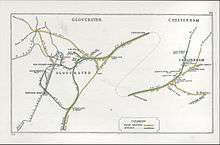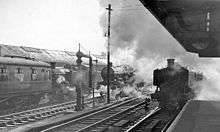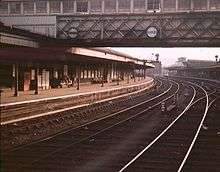Gloucester railway station
Gloucester railway station (formerly known as Gloucester Central station) is a railway station serving the city of Gloucester in England. The station was originally built as the terminus of the Birmingham and Gloucester Railway in 1840, but the arrival of the (broad gauge) Bristol and Gloucester Railway and Cheltenham and Great Western Union Railway in 1844, and then conversion to a through station for the South Wales Railway in 1851 resulted in a very complex layout. Subsequent closures and rationalization have left Gloucester with a station that is located off the main Bristol-Birmingham line, meaning trains that call at Gloucester must reverse except for trains that continue along the Gloucester to Newport Line.
| Gloucester | |
|---|---|
.jpg) Gloucester railway station in October 2019 | |
| Location | |
| Place | Gloucester |
| Local authority | Gloucester |
| Coordinates | 51.865°N 2.239°W |
| Grid reference | SO836185 |
| Operations | |
| Station code | GCR |
| Managed by | Great Western Railway |
| Number of platforms | 4 |
| DfT category | C1 |
| Live arrivals/departures, station information and onward connections from National Rail Enquiries | |
| Annual rail passenger usage* | |
| 2014/15 | |
| 2015/16 | |
| 2016/17 | |
| 2017/18 | |
| 2018/19 | |
| History | |
| 1840 | Birmingham line opened |
| 1844 | C&GWUR opened |
| 1851 | G&DFR opened |
| 1975 | Former MR station closed |
| National Rail – UK railway stations | |
| * Annual estimated passenger usage based on sales of tickets in stated financial year(s) which end or originate at Gloucester from Office of Rail and Road statistics. Methodology may vary year on year. | |
History

The railway development at Gloucester was very complex involving four different railway companies and five distinct railway stations. The first company onto the scene was the Birmingham and Gloucester Railway, which was a standard gauge line opening 4 November 1840. This line from Cheltenham was built by the Birmingham and Gloucester railway on a formation built by the Cheltenham and Great Western Union Railway (see below). The first station was a terminus built on land near the cattle market. This was seen as a temporary structure to be replaced by a more permanent structure nearer the docks when more finance was available, but this never happened and this structure determined the site of the station today.
The Cheltenham and Great Western Union Railway (C&GWU) opened a 7 ft (2,134 mm) broad gauge line from Swindon to Gloucester on 8 July 1844, and built their station adjacent and to the north of the Birmingham and Gloucester station. The line from Gloucester to Cheltenham was upgraded to mixed gauge so that the C&GWU could share tracks to Cheltenham, which meant trains had to reverse at Gloucester.
At the same time as the C&GWU opened, the Bristol and Gloucester Railway also opened a broad gauge line from Bristol to Standish Junction a few miles south of Gloucester, and shared the tracks of the C&GWU into Gloucester station. In 1845, the Midland Railway, which had already bought the Birmingham and Gloucester Railway, also absorbed the Bristol and Gloucester Railway. Similarly, the Great Western Railway had taken over the C&GWU, which resulted in a jointly-owned (MR & GWR), mixed-gauge station from which trains ran on shared mixed-gauge track both northwards and southwards from Gloucester.
In 1847, the GWR opened the Cheltenham Loop line which completed the triangle junction east of the station. This allowed GWR trains to avoid the reversal at Gloucester, but so as to allow GWR passengers to access Gloucester, a link line was built to a station on the loop called the Gloucester T station. Carriages were detached from trains at the T station, turned on turntables and taken into the main Gloucester station. This operation was not very successful and so was abandoned, along with the loop line, in 1851. Hereafter, GWR trains from London to Cheltenham continued to reverse at the main station, a practice that continues to this day.
On 19 September 1851, the Gloucester and Dean Forest Railway and the South Wales Railway opened a line southwestwards from Gloucester towards the Forest of Dean, Chepstow and South Wales. A new, 2-platform through-station was built immediately north of the existing station, although this was rebuilt in 1855 with a longer, single platform after it was found the original station was too small.
Gloucester Railway Stations | |||||||||||||||||||||||||||||||||||||||||||||||||||||||||||||||||||||||||||||||||||||||||||||||||||||||||||||||||||||||||||||||||||||||||||||||||||||||||||||||||||||||||||||||||||||||||||||||||||||||||||||||||||||||||||||||||||||||||||||||||||||
|---|---|---|---|---|---|---|---|---|---|---|---|---|---|---|---|---|---|---|---|---|---|---|---|---|---|---|---|---|---|---|---|---|---|---|---|---|---|---|---|---|---|---|---|---|---|---|---|---|---|---|---|---|---|---|---|---|---|---|---|---|---|---|---|---|---|---|---|---|---|---|---|---|---|---|---|---|---|---|---|---|---|---|---|---|---|---|---|---|---|---|---|---|---|---|---|---|---|---|---|---|---|---|---|---|---|---|---|---|---|---|---|---|---|---|---|---|---|---|---|---|---|---|---|---|---|---|---|---|---|---|---|---|---|---|---|---|---|---|---|---|---|---|---|---|---|---|---|---|---|---|---|---|---|---|---|---|---|---|---|---|---|---|---|---|---|---|---|---|---|---|---|---|---|---|---|---|---|---|---|---|---|---|---|---|---|---|---|---|---|---|---|---|---|---|---|---|---|---|---|---|---|---|---|---|---|---|---|---|---|---|---|---|---|---|---|---|---|---|---|---|---|---|---|---|---|---|---|---|---|---|---|---|---|---|---|---|---|---|---|---|---|---|---|---|---|
| |||||||||||||||||||||||||||||||||||||||||||||||||||||||||||||||||||||||||||||||||||||||||||||||||||||||||||||||||||||||||||||||||||||||||||||||||||||||||||||||||||||||||||||||||||||||||||||||||||||||||||||||||||||||||||||||||||||||||||||||||||||
On 22 May 1854, the Midland Railway opened a new, standard gauge railway between Gloucester and Standish Junction, thus avoiding running on the ex-CGWU line into Gloucester. This new line paralleled the old route as far as Tuffley, where the Tuffley Loop swung into Gloucester and looped back onto the main Bristol-to-Birmingham line. The MR also rebuilt the old 1840 station, lengthening platforms and adding new buildings, but because this was still a terminus and the Tuffley Loop headed eastwards, trains still had to reverse in and out of the station. This anomaly was not sorted out for another 40 years until the MR opened a new station on 12 April 1896, south-east of the existing station, on the Tuffley Loop. The old station was demolished, to be replaced by sidings, and the new MR station was linked to the GWR station by a 250-yards-long, covered footbridge.
In 1901, the Cheltenham Loop, now known as 'the Gloucester avoiding line', was re-instated, primarily for goods traffic, but also for passengers from 1908. Between 1914 and 1920, the GWR station was expanded with a second long platform north of the running lines, two centre tracks for through movements and bay platforms. The two main platforms were also split in two with a scissors crossing in the middle. In 1951, the Western station was renamed Gloucester Central and the Midland station renamed Gloucester Eastgate to avoid confusion.

_Station_geograph-2591649-by-Ben-Brooksbank.jpg)

By the mid-1960s, plans were floated to rationalise the stations - the 1914 upside platform at Gloucester Central was reduced to a parcels-only platform and Gloucester Eastgate was reduced to two platforms. There was also a proposal for an entirely new station on the triangular junction east of the existing stations, to avoid the troublesome reversals, but this was not taken further. Even then, although the through-platforms of Gloucester Eastgate on the Bristol-Birmingham (former Midland Railway) line avoided the still-current problems with trains having to reverse direction, it was seen as a hindrance because the Tuffley Loop line had five level crossings, which caused a lot of traffic problems in town. Therefore, in 1975, Gloucester Eastgate and the Tuffley Loop line were closed and all operations were concentrated at Gloucester Central. This station was redeveloped and re-opened in 1977 with new station buildings and an extended platform at 1977 ft, long enough to take two Inter-City 125 trains then being introduced to the Western Region. In 1984, the 1914 parcels platform was brought back into use as a passenger platform and a new footbridge was opened to provide access.
On New Year's Eve 2010, a fire broke out in the booking office due to arson and the ground floor was severely damaged.[1] The booking office was closed for over a year while the station was refurbished and a temporary ticket office was erected to the right of the entrance. In May 2013, the new booking office was reopened by Richard Graham, MP for Gloucester[2] and new lifts were installed. Further redevelopment is being planned after complaints that the station does not give a good impression for visitors to the city.[3]
In September 2015, Gloucester Railway Station was the first to sign up to a football style card system for dealing with constant trouble makers.[4]
Description
At 1,977 feet 4 inches (602.69 m), Gloucester has the second-longest platform in the UK — the longest is Colchester's platform at 2034 ft (620 m), albeit Gloucester has the longest unbroken platform, as Colchester's is two different physical platforms. The platform was lengthened as part of the 1977 rebuilding by British Rail and was intended to handle two InterCity 125 trains at the same time. These trains were put into service on the Western Region London Paddington to Cheltenham Spa services at this time and all services were handled by the same platform.
The ticket office just inside the station entrance is open for most the day, seven days a week. Snacks and drinks are served in the café on platform 2.
Planned redevelopment
In 2018, the government approved a £3.75 million redesign of the station with the backing of GFirst and Gloucester City Council but the funds are unavailable until April 2020. In February 2019, the council began a £425,000 redesign of the station. The project includes a new underpass and access, redesigned forecourt and cladding.[5][6]
Services
The station is served by several operators.
- Transport for Wales operates an hourly local service (with an hourly gap every three hours during off-peak periods) between Maesteg, Bridgend, Cardiff Central, Chepstow and Cheltenham Spa.[7]
- CrossCountry operates an hourly Cardiff Central - Nottingham via Birmingham New Street service.[8]
- Great Western Railway operates an hourly service to Swindon via the Golden Valley Line with 2-hourly extensions to London Paddington. They also operate an hourly Westbury and Bristol Temple Meads to Gloucester service, with 2-hourly extensions to Cheltenham, Worcester and Great Malvern which include two daily services to and from Weymouth and one to and from Brighton. There is a limited service to Chippenham and Melksham as well as one through service per day to Southampton Central.[9]
- London Midland operated a two-hourly service between Worcester Shrub Hill and Gloucester, introduced in December 2008, but was discontinued in December 2009 due to low passenger usage. A limited once a week Birmingham New Street to Gloucester service (departing Birmingham late Friday evenings, arriving at Gloucester early on Saturday mornings, with no northbound return) was continued by London Midland and its successor, West Midlands Railway, but this was discontinued with the introduction of the May 2019 timetable; the final service ran on Friday 17 May 2019.[10]
| Preceding station | Following station | |||
|---|---|---|---|---|
| Lydney | Transport for Wales Maesteg - Cardiff - Cheltenham |
Cheltenham Spa | ||
| Newport | CrossCountry Cardiff - Nottingham |
Cheltenham Spa | ||
| Lydney | ||||
| Cheltenham Spa | Great Western Railway London/Swindon - Cheltenham |
Stonehouse | ||
| Great Western Railway Cheltenham - Swindon - Westbury |
||||
| Cam and Dursley | Great Western Railway Great Malvern/Gloucester - Westbury |
Terminus or Cheltenham Spa | ||
| Historical railways | ||||
| Haresfield Station closed |
Bristol and Gloucester Railway Midland Railway |
Terminus | ||
| Terminus | Birmingham and Gloucester Railway Midland Railway |
Churchdown Station closed | ||
| Cheltenham (Malvern Road) Line and station closed |
Cheltenham and Great Western Union Railway Great Western Railway |
Stonehouse (Burdett Road) | ||
| Terminus | Ledbury and Gloucester Railway Great Western Railway |
Barbers Bridge | ||
When engineering work occurs in the Severn Tunnel, trains run by Great Western Railway along the South Wales Main Line can be diverted at short notice via Gloucester with trains running from Swansea to Swindon and London Paddington.
References
- "Fire at station booking office in Gloucester". BBC. Retrieved 3 May 2014.
- Rail, Network. "Gloucester MP opens station improvements and gives passengers a lift". Network Rail. Archived from the original on 3 May 2014.
- Citizen, Gloucester. "£2m major revamp for Gloucester railway station unveiled". Gloucester Citizen. Archived from the original on 3 May 2014. Retrieved 3 May 2014.
- "Gloucester Railway Station to introduce football style red and yellow cards to troublemakers". BBC News. 7 September 2015.
- "Major overhaul of Gloucester station and 'infamous' underpass gets go-ahead with £3.7m funding". Gloucestershire Live. 22 February 2018. Retrieved 12 February 2019.
- "'Unattractive' Gloucester railway station work to begin". BBC News. 7 February 2019. Retrieved 12 February 2019.
- Table 57 National Rail timetable, May 2016
- Table 51 National Rail timetable, May 2016
- Table 123 & 125 National Rail timetable, May 2016
- "Birmingham - Worcester - Hereford timetable" (PDF). West Midlands Railway. Retrieved 26 April 2019.
- Oakley, Mike (2003). Gloucestershire Railway Stations. Dovecote Press. ISBN 1-904349-24-2.
- Smith, Peter (1985). An Historical Survey of the Midland in Gloucestershire. Oxford Publishing co. ISBN 0-86093-301-6.
Further reading
| Wikimedia Commons has media related to Gloucester railway station. |